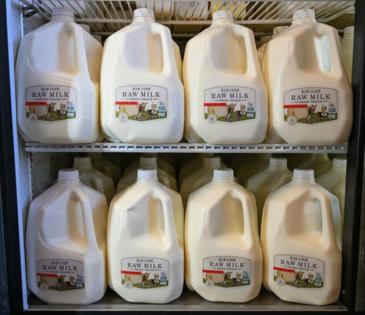Raw milk nearly killed her son. Now avian flu is bringing more attention to its risk
Published in Health & Fitness
SAN JOSE, Calif. -- So far, there have been no reports of illness associated with the bird flu virus that was identified this weekend in a retail sample of raw milk from a Fresno-based dairy.
But the dairy behind the bird flu detection, Raw Farm LLC, is the same company that has previously sold contaminated products, causing many illnesses over the past two decades.
In February, seven people were sickened after eating Raw Farm’s cheddar cheese, according to the U.S. Centers for Disease Control.
Last year, state authorities issued two recalls of its products. The bacteria Campylobacter was found in milk and Salmonella was found in cheese. Between 2012 and 2016, at least 16 people were sickened after eating its raw products, also prompting recalls, CDC and U.S. Food and Drug Administration data shows.
“I almost killed my son when I made the decision to give him raw milk,” said Mary McGonigle-Martin of Murrieta, whose son Christopher almost died in 2006 from hemolytic uremic syndrome from E. coli bacteria after drinking raw milk that she said was purchased from the farm, previously known as Organic Pastures.
“He recovered from renal failure, congestive heart failure, a collapsed lung, acute pancreatitis, high blood pressure and seizures,” said McGonigle-Martin, who now serves as board chair of the nonprofit Stop Foodborne Illness. “When I made the choice to give my son raw milk, I didn’t know something so horrific could happen to him.”
A Raw Farms spokesperson did not immediately return a request for comment.
Bird flu represents a new potential threat in raw milk, which has not been pasteurized, a process that kills germs with high heat. Experts worry that advocacy by Robert F. Kennedy Jr., President-elect Donald Trump’s pick to head the U.S. Department of Health and Human Services, could increase exposure to the virus.
More than 400 cattle herds are now positive for the virus, which represents 40% of the state’s dairy industry.
In the U.S. 53 people have been infected by avian flu. Of these, 21 were exposed by poultry, 31 from dairy cows and one from unknown sources. In California, nearly all of the state’s 29 human cases are linked to dairy farms.
Santa Clara County health officials identified the avian virus in one sample of raw whole milk purchased at a retail outlet, which they have not named, on Nov. 21, according to statements from both the state and the county. The county contacted stores on Friday and recommended they pull the raw milk from sale.
Meanwhile, Raw Farms issued a voluntary recall of the raw milk with a lot ID of #20241109 with a “best by” date of Nov. 27, 2024.
Food scientists warn that other dangerous microbes, not just avian flu, are proven to lurk in milk that has not been pasteurized, a process that kills germs with high heat.
“The risk of potentially getting an infection from a pathogen that comes from raw milk is significantly higher than than you would get from pasteurized milk,” said David A. Mills, a professor in the Department of Food Science & Technology at UC Davis.
We asked food scientists questions about raw milk, pasteurization and the growing avian flu problem.
Q: Can I catch avian flu from raw milk?
A: So far, there have been no human cases resulting from raw milk consumption. But in April, barn cats in Texas died after drinking raw milk from an infected dairy cow. The cats showed symptoms like depression, stiff body movements and blindness. Lab studies have shown similar results.
A study conducted in mice, reported in the May issue of the New England Journal of Medicine, concluded that the virus in “untreated milk can infect susceptible animals that consume it.”
Q: How do microbes get into the milk?
A: Even healthy dairy cattle may contaminate milk with dangerous bacteria like E. coli.
It’s not just because udders are near the rectum, said Mills.
“When you’re on a farm and you have a lot of livestock, then there’s a little bit more feces around than in most places,” said Mills. “Transfers are going to happen.”
After milk is collected, small numbers of bacteria can multiply and grow.
Q: Why does pasteurization make milk safe?
A: Pasteurization kills bacteria by using heat to change the shape of the organism’s enzymes and cell structure.
The exact temperature and time depends on the approach. Milk may be heated to at least 145 degrees for at least 30 minutes, or 161 degrees for 15 seconds. in a large tank. Pasteurization can extend the shelf life of food for several days or weeks.
Q: Is raw milk legal in California?
A: About 20 states prohibit the sale of raw milk, but it may be legally sold in California if a dairy farm in California meets specific requirements for sanitation and licensing, according to the state’s Department of Public Health. Animals must be tested for specific diseases, including brucellosis and tuberculosis.
However, these requirements cannot guarantee that a dairy farm will produce raw milk dairy products that are free from harmful germs, said the California Department of Public Health. That is why farms that produce and sell raw milk must include a warning label on all raw milk dairy products.
Q: Isn’t raw milk supposed to be healthy?
A:There is no difference in the nutritional value between raw milk and pasteurized milk, according to CDPH.
Raw milk is not the same as organic milk or milk that comes from grass-fed animals. Raw milk can still contain harmful bacteria and other germs.
Raw milk also cannot give you “good bacteria,” sometimes called “probiotics.” Probiotics can be found in pasteurized dairy products such as yogurt or kefir, which are safer to eat than raw milk, said CDPH.
Q: What is dangerous about raw milk?
A: Unpasteurized milk, consumed by only 3.2% of the population, and cheese, consumed by only 1.6% of the population, caused 96% of illnesses caused by contaminated dairy products, a 2017 study found.
In the United States, outbreaks associated with unpasteurized dairy products cause, on average, 760 illnesses and 22 hospitalizations a year, mostly from germs such as Campylobacter and Salmonella, according to the CDC.
The greatest risks come from these bacteria:
• Campylobacter: This pathogen can cause reactive arthritis and Guillain-Barre Syndrome, which leads to paralysis.
• Salmonella: This pathogen can cause a blood infection, irritable-bowel syndrome and reactive arthritis. Antibiotic resistance makes Salmonella difficult to treat.
• Ecoli. 0157:H7: This pathogen can lead to Hemolytic Uremic Syndrome (HUS), the most common cause of kidney failure in children. Some children eventually will need a kidney transplant. Children suffering HUS can also lose part or all of their colon, suffer pancreatitis, seizures and strokes. Seizures and strokes can lead to permanent neurological damage.
People at greatest risk of serious illness are children under age 5, adults over 65, pregnant people, and people with weakened immune systems. In general, the majority of victims are children.
©#YR@ MediaNews Group, Inc. Visit at mercurynews.com. Distributed by Tribune Content Agency, LLC.










Comments